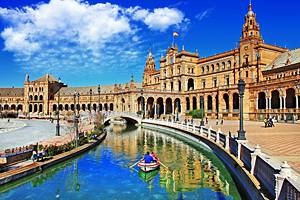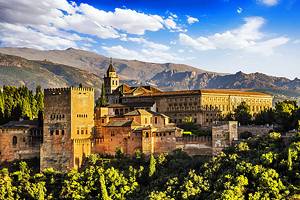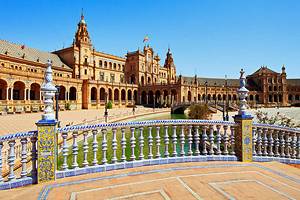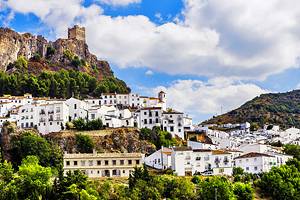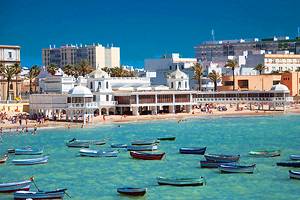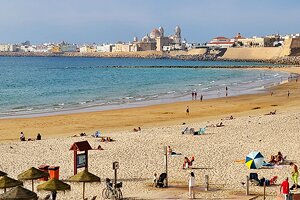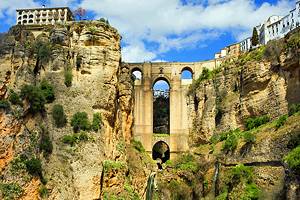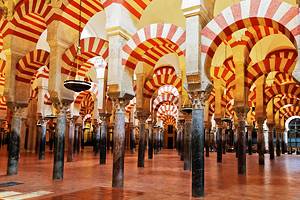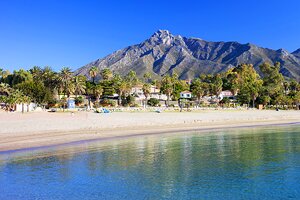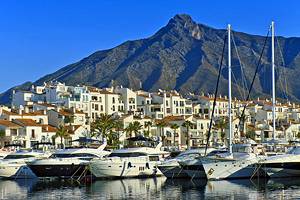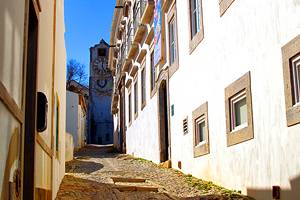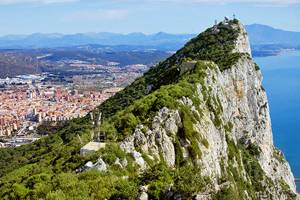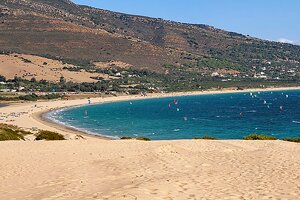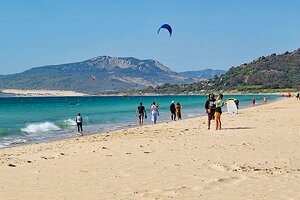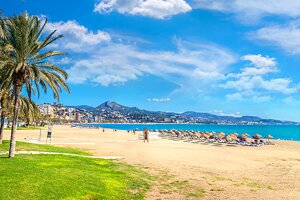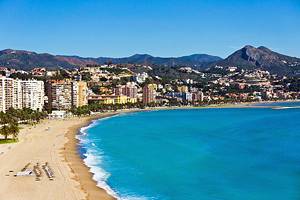Fun Day Trips from Seville
Authors Michael and Lana Law spent 10 weeks visiting the sights of southern Spain, including the top spots around Seville.
With Seville's many attractions, tourists can be forgiven for not wanting to leave. But they would be missing some of the most important and interesting tourist destinations in Spain located near this enchanting city.

After visiting the exquisite medieval Moorish palace in Seville, you'll definitely want to see the amazing Islamic architecture at its finest at the Alhambra in Granada and the Great Mosque in Córdoba.
There are also lesser-known but impressive attractions. A fascinating ancient Roman archaeological site is only a few kilometers outside of Seville, and the quaint White Villages of Andalucía are also within easy reach.
The famed Lusitanian horses practice their ballet in Jerez de la Frontera, just an hour's drive away, and nearby is the birders' paradise of UNESCO-listed Doñana National Park, known as Europe's Everglades. Even exotic Tangier can be visited from Seville in just one day. If all that's not enough, perhaps a day at the beach in Tarifa or a trip to see the famous Rock of Gibraltar.
When compiling this list, we took into consideration not only the destinations but also the length of time and complexity to get to each place. Plan your day-trip adventures with our list of the best places to visit near Seville.
- The Alhambra and Granada's Moorish Quarter
- Córdoba: The UNESCO-Listed Mosque and the Old Jewish Quarter
- Dramatic Ronda
- Seaside Cadiz
- Carmona: A Fortified City with Moorish Castles
- The Whitewashed Village of Arcos de la Frontera
- Historic Gibraltar
- Tarifa
- Exotic Tangier, Morocco
- Andalusian Traditions in Jerez de la Frontera
- Osuna: A 16th-Century Ducal City
- The Roman Archaeological Site of Itálica
- Historic Monuments in Ecija
- Birdlife at the Parque Nacional de Doñana
- Map of Day Trips from Seville
The Alhambra and Granada's Moorish Quarter

Heading the list of the top tourist attractions in Spain is the Alhambra, a magnificent assemblage of palaces crowning a hilltop in Granada. This is a long day trip from Seville, but worth it if you have your heart set on seeing the Alhambra. The drive time each way is just under three hours.
The decorative detail that fills the royal palace of the Nasrid dynasty is the finest example of the artistry of Spain's Islamic period. From the 13th through the 15th centuries Andalucía was the Western capital of the Islamic world and represented the highest achievements of culture in medieval Europe.
The Alhambra was the seat of the dynasty, a complex of palaces, gardens, towers, walls, and a mosque all adorned in delicately carved stone filigree and incredibly intricate tilework. That's just the Nasrid palaces.

Also in the Alhambra is the still unfinished palace built for the Emperor Charles V, Spain's finest example of High Renaissance architecture. Be sure to climb to the adjoining Generalife for the views of the Alhambra palaces from its beautiful terraced gardens.
Daily admission to the Alhambra is limited to a certain number of visitors, be sure to book your ticket or tour well in advance of your planned visit.
Córdoba: The UNESCO-Listed Mosque and the Old Jewish Quarter

Cordoba is a beautiful city and deserves more than just a quick stop, but if you only have time for a day trip, it's worth it. You can drive from Seville to Cordoba in less than two hours.
Magnificent architecture and quaint old quarters make it a pleasure to wander the narrow streets and visit the awe-inspiring monuments.
The most important sight in Córdoba is the UNESCO-listed La Mezquita (Great Mosque), an 8th-century mosque that is considered one of the finest Islamic buildings in the Western world.
For centuries, Muslims, Christians, and Jews lived together in harmony, while contributing to intellectual achievements that made Córdoba the greatest capital city in Europe. The mosque was converted to a cathedral in 1523 under the Catholic Monarchs.

Be sure to spend time exploring the Judería, the old Jewish quarter, which has a splendid 15th-century Mudéjar-style Synagogue and Museum of Sephardic Jews (Casa de Sefarad). This neighborhood is a charming tangle of narrow, winding lanes and atmospheric squares.
The Jewish Quarter's lovely whitewashed houses are humble abodes. Most of the residences feature flower-bedecked patios (interior courtyards). During the Fiesta de los Patios de Córdoba festival in May, locals compete for the prize of "most beautiful patio."
More Andalusian courtyards and gardens can be found at the Palacio de los Marqueses de Viana (an aristocratic palace) and the Alcázar (Moorish castle), which is landscaped in a distinctive Arabian style.

Dramatic Ronda

One of the Pueblos Blancos (White Villages), this breathtaking cliff-top town is one of the most dramatic sites in Andalusia. Ronda is perched on a plateau overlooking El Tajo gorge with the famous Puente Nuevo bridge straddling the 130-meter-deep ravine.
Ronda is less than a two-hour drive from Seville, making it an easy day trip and a nice escape from the busy streets of Seville. If you are on your way to Granada from Seville, you can tuck Ronda into your itinerary for a stop along the way. You can also take a train from Seville to Ronda, which takes about 2.5 hours each way.
Sensational sweeping views of the landscape are found at the Casa del Rey Moro gardens and the Alameda de José Antonio park. Other must-see sights in Ronda include the Baños Árabes (medieval Arab Baths) and La Cuidad, the historic Islamic quarter, which reflect the town's Moorish heritage.
Ronda is also legendary for bullfights and bandits. In early September, the Feria Goyesca de Pedro Romero (a week-long festival with costumed parades, flamenco performances, and traditional bullfighting) takes place throughout the town and at the Plaza de Toros bullring. The bullring and its bullfighting museum are open year-round.

The Museum of Bandits shares stories about the rough-and-tumble outlaws of the 19th century, who lived in the mountains around Ronda.
Seaside Cadiz

If you are looking for some beach time, you should consider a trip to Cadiz. It's only a 1.5-hour drive from Seville to Cadiz, where you can set up on the sand or choose to wander through the historic city center.
Everything about Cadiz exudes seaside Mediterranean charm, from the balmy weather and sea breezes to sunny plazas and waterfront promenades.
The cosmopolitan city is actually a collection of atmospheric old barrios such as El Pópulo, packed with cobblestone streets and narrow alleyways, and La Viña, the historic fishermen's neighborhood, where you can stop in for a seafood meal.
Save time for wandering around the old gypsy quarter (Santa María), listening for melodies of flamenco songs. Within its urban boundaries, Cádiz has excellent sandy beaches, and the city is also surrounded by the dreamy Costa de la Luz, a spectacular stretch of unspoiled sandy coastline.
- Read More: Tourist Attractions in Cádiz
Carmona: A Fortified City with Moorish Castles

Surrounded by the remains of old Roman walls, this ancient town is nestled in the countryside just 35 kilometers (a 30-minute drive) from Seville. Towering above are the town's two most prominent sights: the Alcázar del Rey Don Pedro, the Moorish fortress, and the 15th-century Church of Santa María la Mayor.
Another noteworthy religious landmark is the Church of San Pedro, which was designed with a tower that resembles La Giralda at the Seville Cathedral. At the center of Carmona, the Plaza San Fernando is a typical Andalusian town square graced by elegant historic buildings.
To get a sense of Carmona's ancient heritage, visit the Seville Gate, which dates back to the Carthaginian era of the 9th century BC.
The Whitewashed Village of Arcos de la Frontera

Arcos de la Frontera has a way of seducing visitors with its charming whitewashed houses and spectacular views. Listed as a National Historic-Artistic Monument, Arcos de la Frontera is a one-hour drive from Seville and is considered a gateway to exploring the Pueblos Blancos (White Villages) of Andalusia.
Similar to Ronda, the clifftop town has Moorish roots. The 15th- to 16th-century Basilica of Santa María de la Asunción features Mudéjar architectural elements that are common in this region. The Church of San Pedro is also noteworthy for its decorative Baroque facade.

If you visit during Easter Week (Semana Santa), you'll be able to experience the town's traditional festival.
Arcos de la Frontera is also remarkable for its regional cuisine. The town's historic center has many good tapas restaurants with delightful patios.
Historic Gibraltar

Gibraltar, with its array of things to do, is a perfect day trip destination from Seville if you don't mind a long day. It's about a 2.5-hour drive each way.
The area has a bit of everything: rich cultural heritage, famous monkeys, and, of course, the towering Rock of Gibraltar.
The imposing Rock of Gibraltar should be on everyone's itinerary. Take a cable car to the top and soak up the impressive views out over the Mediterranean Sea and to Africa, only 14 kilometers away. No trip would be complete without stops in the Gibraltar Nature Reserve and St. Michael's Cave where the famous (some would say infamous!) Barbary macaques entertain visitors with their antics.
History abounds here as well. Be sure to stop in at the Moorish Castle, dating from 711 CE and go deep underground in the Siege Tunnels.
Getting to Gibraltar from Seville is a somewhat tricky endeavor owing to the fact that Gibraltar is actually part of England and as a result, a border crossing is involved. A great way to avoid any issues is to take a guided day-trip.
Tarifa

Tarifa is a fun small town with fantastic beaches and a fun vibe. Am easy 2.5-hour drive from Seville, this water sports hot spot is well worth a visit — especially if the wind is up. Legions of water sports enthusiasts descend on this town each summer to ride the wind and waves at the world-famous Playa de Valdevaqueros, one of the best beaches in Spain.
Kiteboarding, windsurfing, and more recently winging, are all popular, and when all the participants are out on the water, it's a kaleidoscope of color and craziness.
However, Tarifa isn't all about the ocean, the town has a wonderful Old Town chock full of good restaurants with lively patios that stay busy late into the evening.
Exotic Tangier, Morocco

If you want to add Africa to your itinerary, a day trip to Tangier from Seville is a great option. Reached from Seville by ferry from the coastal town of Tarifa, this is a long day that takes a bit of coordinating, so you may want to consider joining a tour to keep things simple.
The Moroccan city of Tangier is perhaps best known as the home of the famous Kasbah, where Sultan Moulay Ismail built his palace, the Dar el Makhzen, in the 17th century. Today the palace, resplendent with its marble courtyard and intricately carved ceilings, houses a museum of archaeology.
The Kasbah sits atop the city, with views over the tangled medina (old town) and the sea. The medina is a labyrinth of narrow lanes and alleys that seem to converge on the Petit Socco, a lively square.
To the east of the Petit Socco is the Grand Mosque, and to the west is the Spanish Church of the Immaculate Conception, built in 1880.
Andalusian Traditions in Jerez de la Frontera

If you want a very simple day trip, Jerez de la Frontera is just over an hour's drive or train ride from Seville.
This old aristocratic town takes pride in its traditions. A top attraction in Jerez is the Fundación Real Escuela Andaluza del Arte Ecuestre (Royal Andalusian School of Equestrian Art Foundation), where prestigious pedigreed Andalusian horses prance in perfect form.
Equestrian enthusiasts will especially enjoy the Jerez Horse Fair (Feria del Caballo), a 500-year-old custom that continues every year in May. The event features tapas tastings and a children's amusement park.
Jerez de la Frontera also boasts a center devoted to the art of flamenco, the Centro Andaluz de Documentación del Flamenco. To experience authentic flamenco performances, the best time to visit is at the end of February and in early March for the Festival de Jerez held at the Teatro Villamarta.
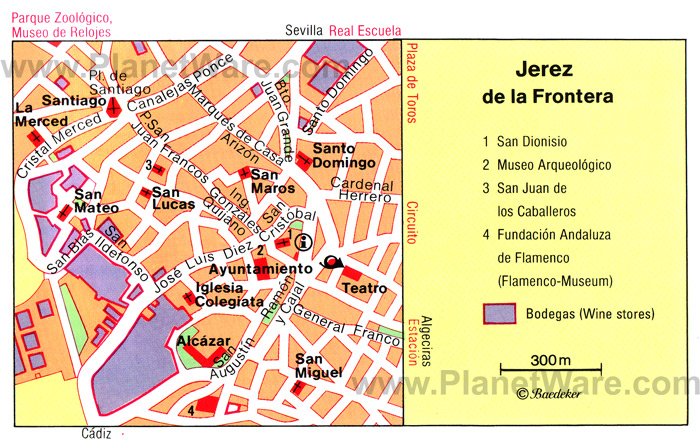
Osuna: A 16th-Century Ducal City

Listed Historic-Artistic Monument, Osuna was an important town during the Roman era and in the 16th century, became an established ducal city. Osuna is also known for its traditional religious celebrations during Semana Santa (Easter week).
The town boasts impressive monuments, including the Andalusian Renaissance-style Ducal Pantheon and the Collegiate Church of Santa María de la Asunción (Colegiata de Osuna). The church houses the Museum of Religious Art, which contains masterpieces of 17th-century painting by José de Ribera.
At the Plaza Mayor in the center of town is an old Moorish tower that houses the Archaeological Museum.
Osuna is found in the countryside, 92 kilometers southeast of Seville.
The Roman Archaeological Site of Itálica

Just 13 kilometers (a 15-minute drive) from Seville are the ancient Roman ruins in Itálica. The site was settled by the Romans in 206 BC and later, under the rule of Emperor Augustus, Itálica was founded as a town and began minting money. Itálica was also the birthplace of the emperors Trajan and Hadrian.
Today, you can visit the incredible archaeological site to discover ruins of old streets, buildings, and mosaics, which are found in their original location.
Historic Monuments in Ecija

Known as the City of Towers, Ecija boasts 11 historic towers and nine church steeples. Visitors will be awed by the town's religious monuments, including the 15th-century Church of San Gil and the 13th-century Church of Santa Cruz that was converted from a mosque.
During the 16th century, the town had a significant aristocratic presence, seen in the lovely Los Palmos Palace, designed around a courtyard filled with fragrant orange trees.
The town also has a marvelous Palace of Justice building, the Mudejar-style Casa de las Tomasas, as well as elegant town squares featuring fountains.
Ecija is located 86 kilometers from Seville, about a one-hour drive or two-hour bus ride.
Birdlife at the Parque Nacional de Doñana

This UNESCO-listed national park is a protected zone of wetlands for migrating birds. The Parque Nacional de Doñana was formed from the delta of the Guadalquivir River. This river was known by the Moors as the Wada-I-Kebir, which translates to "Big River."
Bordering the delta's sandbar are marshlands that are home to a diverse bird population including extraordinary species such as flamingoes and Spanish imperial eagles. The park also has scrublands and coastal dunes.
To reach the Parque Nacional de Doñana from Seville (36 kilometers away) is about a 45-minute drive.


